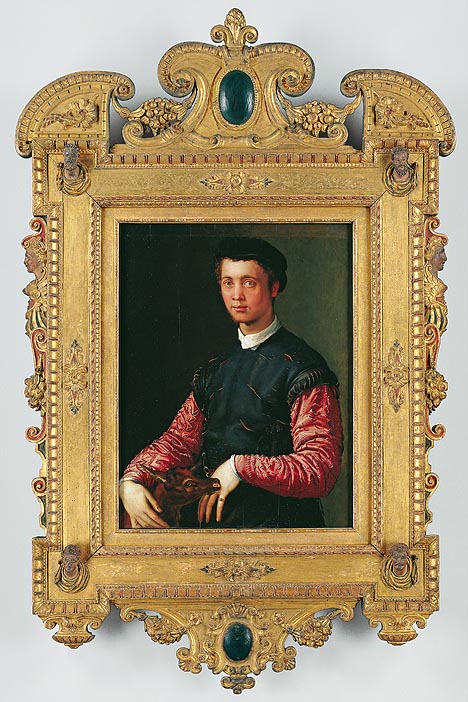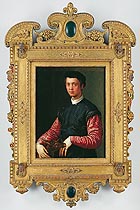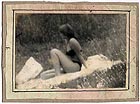
translated and summarized by: Liz Wollner-Grandville,
English summary October 19 - 25
Liechtenstein Museum: Structure and Ornament – The picture and its frame
A frame is not a frame
Throughout the course of history, frames have often been considered as art works; as art works with a symbiotic character, as they had a function in relationship to the picture (painted or inlaid), to a relief, or a sculpture. They accentuated the effect of the object they surrounded and gave it more depth. At first - with the invention of the panel painting - as a fastened or integrated frame; everything was made of one piece. Later, the outer part took a life of its own and was not only made of wood. Semiprecious stones, ceramics, ivory, and diverse metals, including paper maché were processed in many different techniques. At times they were simple, sometimes richly adorned and attuned to the furniture in the room.
But there were also tendencies to separate the pictures from their frames and to present frameless pictures. In turn, collectors began to value these frames for their preciousness.
In the past couple of years, one again strives to present artwork (if not with its original frame) then at least with a frame that accords the object its originally intended radiation.
The exhibition presents the evolution of frames by dividing the museum space into numerous “islands” and displaying which effect a painting had on leather wallpaper, how rooms were furnished during the Biedermaier and Classism eras, how large a Baroque mirror can be (and how heavy). Putti are painted behind glass holding golden twines, Diana is surrounded with kill, fruits are made of wood and ceramics, and angular shapes link with rounded ones, enamel pairs with tortoiseshell.
One learns everything about the difference and the names of the various types of frames: integrated (fixed) frame, tabernacle, tondo, cassette (plate, profile) and the special forms: Sansovino, Salvator-Rosa and Canaletto frames, as well as cabinet, splendour or ornate frames. Everything that is hidden behind the underlying terms is well worth seeing and experiencing.
By Maria-Gabriela Martinkowic
Liechtenstein Museum
1090 Vienna, Fürstengasse 1, until 09.11.09
www.liechtensteinmuseum.at
Galerie Meyer Kainer: Precarious Form I – Precarious Sculptures
Mainstream feeling
The topic sounds familiar: Precarious sculptures - weren’t they already shown in this city once before? Absolutely: in 2004, when the Kunsthalle Wien organized the exhibit “Sculpture. Precarious Realism between melancholy and humour”. Five years later, the Gallery Meyer Kainer is presenting the group exhibit “Precarious Form I / Precarious Sculptures”, curated by Veit Loers.
While the Kunsthalle exhibit dealt with the topic extensively, the gallery gets by with less space and less theoretical accompaniment. A small number of artists are presented both in this as well as the 2004-exhibit, a fact that does no harm: Naturally, Franz West and Urs Fischer are part of this discourse on contemporary sculpture – especially regarding positions, which, as stated in the summary published by the gallery, “display formal tendencies regarding fragmentation, contingency and decomposition” and couldn’t care less about compositional hierarchies.
Yet the feat at the beginning of the 21st century would be to find positions that do not correspond with these criteria – today the not-perfect and not-through-composed is the rule, not the exception; sculptures will always display parts of something else. After all, collage techniques have been around since the historic Avant-garde.
Nevertheless, the exhibition is constructed with considerable sensitivity for material and formal connections – Franz West’s unsteady table corresponds perfectly with Jason Rhoade’s barrel-assemblage forming a wooden car. Jonathan Meese’s dreary trash doll “Colonel V. de Bruzz” matches the equally dismal grill-station figures Vergil and Dante by Thomas Zipp, and the minimalistic pedestal by Anita Leisz blends with Heimo Zobernig’s figure on a black shelf.
This exhibition, for sure, does not present sidelines or novelties regarding the discourse on sculptures, but their mainstream; but with keen insight.
By Nina Schedlmayer
Galerie Meyer Kainer
1010 Vienna, Eschenbachgasse 9, until 07.11.09
www.meyerkainer.com
Palais de Tokyo: Chasing Napoleon
Rubik’s Cube
Those who always wanted to find out which books the Unabomber read should visit the Palais de Tokyo. Here Dora Winter reconstructed his library. The Books range from topics such as “Women’s Psychology” or “Edible Wild Plants”, Albert Speer’s “Spandau” or Leo Tolstoy’s “The Cosacks”, and if you want to investigate his traces in more detail, you are free to read them.
Ted Kacynski seems to be the key part of “Chasing Napoleon”, which was curated by Marc-Olivier Wahler in the rooms of the building planned to be the EXPO pavilion. Numerous other works attempt to get to the bottom of the former math professors life, who kept the USA in suspense for decades: Robert Kusmirowski reconstructed the hut in which he devised the letter bombs and his manifesto; Gardar Eide Einarsson presents Kacynski’s mug shot and some of his notes, which offer a detailed list of his criminal strategy.
But Kaczynski’s story only serves as a motive for a more extensive confrontation - and this is where everything becomes a bit blurred - with fleeing in general and escapism in detail. Paul Laffoley’s psychedelic art-natural science-esoteric-diagrams are more comprehensible in this context, as well as Christoph Büchel’s reconstruction of Saddam Hussein’s hiding place and Ryan Gander’s wall-hole, which clears the view to the plants outside.
The exhibition is a bit like Rubik’s Cube: each time you think you are on the brink to success, something doesn’t fit. At one point, it’s Tony Smith’s rhomboid, which refuses the entire concept, and then it’s Tony Matelli’s burning ceramic banknotes. But at least it motivates to constantly twist and turn the entire story – not a bad thing at all.
By Nina Schedlmayer
Palais de Tokyo?
75116 Paris, 13 avenue du Président Wilson, until 17.01.10
www.palaisdetokyo.com
Galerie Elisabeth und Klaus Thoman: Miroslav Tichy
From the archives of a poacher
Naturally these pictures confront us with traditional male constructions of a viewpoint. And naturally their context can be described as a voyeuristic structure. Yet reflections of perception, coined by mass media in the direction of paparazzi or stalking, do not offer an adequate form of interpretation for Miroslav Tichy’s photographs.
Ever since the psychiatrist and art expert Roman Buxbaum came to terms with these works, and ever since Harald Szemann presented them at the 2004 Seville Biennial, Tichy’s works have undergone an unparalleled boom. Purchases and exhibitions by the Kunsthaus Zurich, the MMK in Frankfurt or the Centré Pompidou drive the boom even further.
The evolution of the photos, which appear like tattered excavations from a grubby archive belonging to an obsessed person, is adventurous. For more than three decades the artist, born 1926 in the Moravian town of Kijov, was on the hunt for motives. He took photos of women in sexualized positions or those evoking erotic fantasies with his self-constructed cameras from of a hidden view. Every day, he developed up to 60 prints out of 100 to 200 negatives.
The vast number of pictures, and foremost the repressive conditions, which prevailed in socialist Czechoslovakia, lead to a maze of explanations for the genesis of the mysterious oeuvre. According to the Canadian theoretician Clint Burnham, the key lies in the dyad of sex and politics. Following his studies at the Art Academy in Prague from 1946 to 1948, Tichy opposed the new cultural policies and their doctrine of socialist realism; and against the propaganda of technological progress. Obstinately he turned to his “studies” of the female body, as the academies abolished nude drawings. He operated with primitive equipment beyond the paradigms of industrial and ideological armament.
Following the presentation of some of his works at the “City of Woman” exhibit at the Salzburg Fotohof Gallery in 2007, the Gallery Elisabeth and Klaus Thoman now organized Tichy’s first solo exhibition in Austria. The pictures perturb. Also because their framing and fragile materiality remind of photography as a formerly tangible media. They confront us with the insecure status of the media. At the same time, we are unmasked as voyeurs; both in line with sexuality and in general, and as an obscene urge, to constantly transform reality into floating pictures.
But one must keep in mind that Tichy's works depict self-conscious, sometimes cheeky girls and women, who have one thing in common: they do not work. Tichy began to paint in the Czech scene and in 1954, he founded the Brnenska Peta (Brno Five) group with his friends. Ever since he announced his first solo exhibit he was exposed to persecution and observation and was most probably tortured. The gloomy film portrait by Nataa von Kopp “Worldstar” (2007) documents that the 83-year old has given up on life in the midst of his humid rooms piled with photos. He makes practically no attempt to take part in his late fame. This makes the transformation process of Tichy’s photographs on the levels of art industry and market to an irritating endeavour. All of these cracks and depths in Miroslav Tichy’s work bring up numerous fundamental questions.
By Roland Schöny
Galerie Elisabeth und Klaus Thoman?
6020 Innsbruck, Maria-Theresien Straße 34, until 04.11.2009
www.galeriethoman.at
Mehr Texte von translated and summarized by: Liz Wollner-Grandville


 Teilen
Teilen





